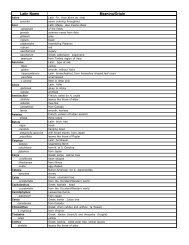Arborvitae - Beeson's McHenry County Nursery, Inc.
Arborvitae - Beeson's McHenry County Nursery, Inc.
Arborvitae - Beeson's McHenry County Nursery, Inc.
Create successful ePaper yourself
Turn your PDF publications into a flip-book with our unique Google optimized e-Paper software.
<strong>Nursery</strong> News<br />
March 2011 - Research & Development<br />
www.beesongrows.com/ArchivePage.html<br />
©2007 Beeson’s <strong>McHenry</strong> <strong>County</strong> <strong>Nursery</strong>.<br />
©2007 Glacier Oaks <strong>Nursery</strong>.<br />
All Rights Reserved.<br />
An<br />
<strong>Arborvitae</strong>-A-Day...<br />
The Common name <strong>Arborvitae</strong> comes from the Latin word meaning ‘tree of life’ and dates from the 16th century when Native<br />
Americans and early settlers used the Vitamin C rich foliage to treat scurvy.<br />
<strong>McHenry</strong> <strong>County</strong><br />
<strong>Nursery</strong>, <strong>Inc</strong>.<br />
Here at <strong>McHenry</strong> <strong>County</strong> <strong>Nursery</strong> and Glacier Oaks<br />
<strong>Nursery</strong>, the ‘tree of life’ is our lifeblood, and we grow several<br />
arborvitae cultivars up to a full and heavy 8-10ft. We propagate<br />
our <strong>Arborvitae</strong> from hardwood cuttings. The cuttings are rooted<br />
in sand and transferred to our Jumbo pots where they grow for<br />
two years, creating fibrous root systems and heavy tops. We grow<br />
them in beds in our forest soils for two to three more years before<br />
they are transplanted again to their finishing spacing. Here they are<br />
grown until harvest several years later. A hardy, healthy,<br />
root-pruned arborvitae for transplanting into a screen could be<br />
anywhere from 7 to 15 years old!<br />
We strive to balance our plants and our environment with<br />
sustainable practices that ensure a healthy plant that survives and<br />
thrives in your design.<br />
American <strong>Arborvitae</strong><br />
Thuja occidentalis is native to North America and along with the<br />
cultivars, are great trees for the Midwest, preferring colder climates.<br />
Bark: red-brown, furrowed and peeling bark<br />
Foliage: Flat sprays with scale-like leaves<br />
Fruit: Cones are slender, yellow-green to brown<br />
Soils: Prefers Moist soils but can withstand periods of<br />
extreme drought. Adaptable to a variety of soil<br />
conditions - poor soils that are rocky, sterile, dry, wet,<br />
compacted, clayey, exposed sites<br />
pH: prefers alkaline pH. will survive, but not thrive, in<br />
neutral or acidic pH soils.<br />
Site: Prefers full sun but will tolerate partial sun<br />
Well-Rounded<br />
<strong>Arborvitae</strong><br />
<strong>Arborvitae</strong> are most often used for<br />
hedges or year round privacy<br />
screens (see screening article). They<br />
also make a good wind block and<br />
accent tree to soften a view.<br />
<strong>Arborvitae</strong> can also be used in<br />
buffer strips around parking lots,<br />
median highway plantings or as a<br />
reclamation plant. The shrub type<br />
cultivars are naturally rounded, and<br />
make an excellent low maintenance<br />
foundation or border plant.<br />
Inquiries or more information is available by contacting <strong>McHenry</strong> <strong>County</strong> <strong>Nursery</strong> Propagator Mary McClelland<br />
<strong>Arborvitae</strong> Care<br />
Once established, arborvitae require little maintenance, and are<br />
relatively disease and insect free. Fertilizer applied every few years<br />
aids in faster growth. Pruning, if desired to stimulate growth,<br />
should be done early before new growth emerges. Growth will<br />
be mostly on branches and stems that have been cut back the<br />
previous year. New growth is a bright yellow green, an attractive<br />
contrast with the rest of the plant.<br />
Wildlife Love <strong>Arborvitae</strong><br />
An added benefit to planting arborvitae is the cover they provide<br />
for many types of wildlife year round. <strong>Arborvitae</strong> are important<br />
trees in natural areas. The leaves are one of the most popular<br />
winter foods for white-tailed deer and<br />
other mammals. Over-browsing can<br />
be a problem in heavy deer populations<br />
or hard winters. The arborvitae’s<br />
dense form provides cover for birds<br />
and small mammals, and groupings of<br />
arborvitae provide cover in the winter<br />
for white-tailed deer, moose, and<br />
black bear.<br />
Phone (815)943-TREE www.beesongrows.com mcn@beesongrows.com<br />
1<br />
Fax(815)943-3511<br />
We Print on<br />
Recycled Paper<br />
Do You?
<strong>Nursery</strong> News<br />
June 2007 - Research & Development<br />
www.beesongrows.com/ArchivePage.html<br />
©2007 Beeson’s <strong>McHenry</strong> <strong>County</strong> <strong>Nursery</strong>.<br />
©2007 Glacier Oaks <strong>Nursery</strong>.<br />
All Rights Reserved.<br />
An<br />
<strong>Arborvitae</strong>-A-Day...<br />
Big or Small, We have them all...<br />
Over 300 cultivars have been selected for different shapes, sizes, and uses.<br />
We grow a variety of cultivars that perform well in the nursery and the landscape.<br />
Mission (Techny) (15'x15')<br />
Excellent dark green foliage year<br />
round. Broad pyramidal form,<br />
ours are extremely dense<br />
and heavy, perfect for an<br />
instant hedge.<br />
Holmstrup (5'x2')<br />
Extremely compact upright pyramidal<br />
plant. Bushy bright green textured foliage.<br />
Emerald (10'x3')<br />
Displays excellent heat tolerance, as<br />
well as being cold hardy to -40<br />
degrees. Does not discolor in winter.<br />
Foliage is a bright emerald green.<br />
Compact, pyramidal growth habit<br />
has a formal appearance.<br />
Pyramidal<br />
(15'x4')<br />
Narrow<br />
pyramidal, formal<br />
in outline with<br />
bright green, soft<br />
textured foliage.<br />
Best in full sun<br />
and protected<br />
areas.<br />
Little Gem (3'x6')<br />
Lush dark green foliage during<br />
the summer, slightly brownish<br />
during winter. Dwarf, dense,<br />
round form.<br />
Inquiries or more information is available by contacting <strong>McHenry</strong> <strong>County</strong> <strong>Nursery</strong> Propagator Mary McClelland<br />
Phone (815)943-TREE www.beesongrows.com mcn@beesongrows.com<br />
2<br />
Fax(815)943-3511<br />
Woodward (6'x6')<br />
A very uniform, naturally globe-shaped<br />
arborvitae that never needs trimming.<br />
Foliage is vertically radiating outward from<br />
center of plant – a neat compact shape.<br />
Excellent foundation plant that is quite hardy.<br />
Dark Green (20'x8')<br />
Pyramidal form with dark<br />
green foliage that<br />
lasts throughout<br />
the winter.<br />
We Print on<br />
Recycled Paper<br />
Do You?




